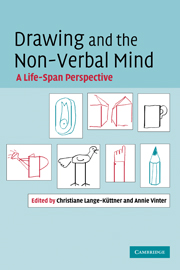Book contents
- Frontmatter
- Contents
- Contributors
- 1 Contemporary enquiries into a long-standing domain: Drawing research
- Part I Self, symbols and intention
- Part 2 Syntax, space systems and projection
- Part III Aging, blindness and autism
- 13 Benefits of graphic design expertise in old age: compensatory effects of a graphical lexicon?
- 14 Drawing as a ‘window’ on deteriorating conceptual knowledge in neurodegenerative disease
- 15 Drawings by a blind adult: orthogonals, parallels and convergence in two directions without T-junctions
- 16 Differences between individuals with and without autism in copying tasks: how knowledge interferes when drawing perspective
- Index
- References
14 - Drawing as a ‘window’ on deteriorating conceptual knowledge in neurodegenerative disease
Published online by Cambridge University Press: 22 September 2009
- Frontmatter
- Contents
- Contributors
- 1 Contemporary enquiries into a long-standing domain: Drawing research
- Part I Self, symbols and intention
- Part 2 Syntax, space systems and projection
- Part III Aging, blindness and autism
- 13 Benefits of graphic design expertise in old age: compensatory effects of a graphical lexicon?
- 14 Drawing as a ‘window’ on deteriorating conceptual knowledge in neurodegenerative disease
- 15 Drawings by a blind adult: orthogonals, parallels and convergence in two directions without T-junctions
- 16 Differences between individuals with and without autism in copying tasks: how knowledge interferes when drawing perspective
- Index
- References
Summary
Patterson and Erzinçlioǧlu discuss drawing as one technique for investigating the nature of semantic memory and its disorders. Semantic dementia (SD) is a neurodegenerative condition characterized by gradual degradation of central conceptual knowledge. Given that patients with SD have (a) well-preserved perceptual and motor skills (which means that they can easily copy drawings with the model present) and (b) reasonable preservation of at least some aspects of short-term and episodic memory, the technique of delayed copy drawing can be employed. A line drawing of a familiar object is presented for the patient to study; it is then removed and the patient does something else for 10 or 15 seconds, and is finally asked to draw what she or he was looking at. Because literal visual memory is fragile even in the normal cognitive system, the delayed-copy task evokes and relies on a combination of short-term visual memory and long-term conceptual knowledge. Thus normal individuals, in delayed copy drawing of a rhinoceros, draw it with horns and ‘armoured’ skin not only because they remember seeing these specific features but also because their conceptual knowledge of rhinos demands these features in the reproduction. The degraded knowledge in SD patients means that they cannot recognize this thing as a rhinoceros; they only know it is some sort of animal. The impoverished drawings that they produce a mere 10 seconds after studying the targets provide an informative window on the quality of their conceptual knowledge.
- Type
- Chapter
- Information
- Drawing and the Non-Verbal MindA Life-Span Perspective, pp. 281 - 304Publisher: Cambridge University PressPrint publication year: 2008
References
- 10
- Cited by

